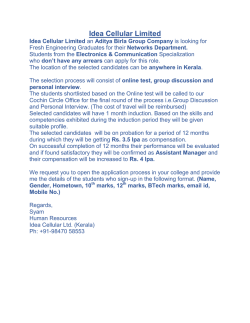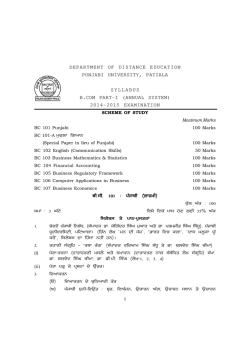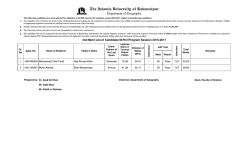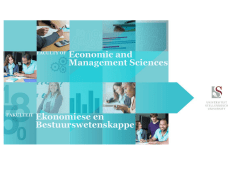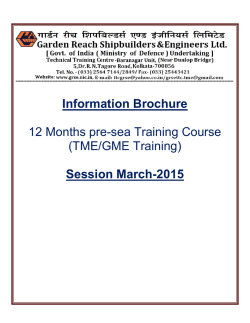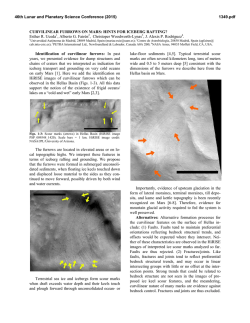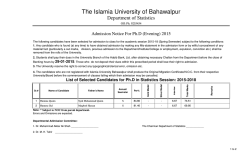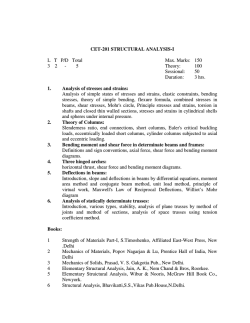
department of distance education punjabi university
DEPARTMENT PUNJABI OF DISTANCE UNIVERSITY, EDUCATION PATIALA S Y L L A B U S POST GRADUATE 2014 DIPLOMA/M.A. PARTJOURNALISM & T-I C O M M U N I C A T I O N AND 2015 EXAMINATIONS (ANNUAL) MASS PAPER-I : INTRODUCTION TO MASS COMMUNICATION Time allowed : 3 Hours Pass Marks : 35% Max. Marks : 100 Theory : 80 Marks Internal Assessment : 20 Marks INSTRUCTIONS FOR THE PAPER SETTER The question paper will consist of five sections. A, B, C, D and E. Section A, B, C and D will have two questions from the respective sections of the syllabus and will carry 15 marks each. Section E will consist of 10 short-answer type questions which will cover the entire syllabus uniformly and will carry 20 marks in all. INSTRUCTIONS FOR THE CANDIDATES Candidates are required to attempt one question each from the sections A, B, C and D of the question paper and the entire section E. SECTION-A Communication : Meaning, Definition and Nature; Elements and process of communication; Functions of human communication and Mass communication; Various forms of communication : Intra-personal, Inter-personal, Group, Public and Mass communication; Non-verbal and verbal communication; Communication barriers; Communication and human relationship. SECTION-B Scope, functions and limitations of communication models; Development of communication models from simple to complex; Powerful, moderate and limited effects models; Models of Aristotle, Dance, Harold Lasswell, Osgood, Wilbur Schramm, George Gerbner, Westley and MacLean. SECTION-C Theories of direct and indirect influences; Bullet theory, Two-step flow theory, Theory of cognitive dissonance, concepts of selective exposure. Selective preception and selective retention; Cultivation theory, Agenda setting theory, Uses and Gratification theory; Mass society theory, Media System : Authoritarian, Liberatarian Social Responsibility, Democratic participant theory. SECTION-D Mass Communication through traditional and Modern Media; Effects of Mass Media 1 PGDJMC/M.A.- I (J.M.C.) 2 SYLLABUS on Culture and Society; Media and Cultural Imperialism; Information Society; Mass Communication in Digital era. Note : Class Text of 20 marks will be held for Internal Assessment. BOOKS RECOMMENDED 1. 2. 3. 4. 5. : : : : : De Fleur and B. Rokeach Denis McQuail Agee, Ault, Emery Gurmeet Maan Whitney, Wartella and Windohl : : : : : YS Yadav & Pradeep Mathur Emery Smithe Denis McQuail Subir Ghosh IIMC : : : : Budd and Rohen William Francois R.K. Ravindran Uma Joshi : Sitaram, Cogdell : Dua M.R. Vivek Gupta 17. Theories of Mass Communication Mass Communication Theory Perspectives in Mass Communication The Study of Mass Communication Mass Communication Review Yearbook (Vol. 3) Issues in Mass Communication Reading in Mass Communication Communication Models Mass Media Today Communication and the Traditional Media Approaches to Human Communication Introduction to Mass Communication Media and Society Text book of Mass Communication and Media Foundations of Inter-cultural Communication Theories in Indian Communication Metropolitian Book Company More effective Communication : 18. The Art of effective Communication : 19. Perspectives in Mass Communication : 20. Mass Communication Theory : 21. Effective Communication : 22. Understanding Mass Communication : 23. The Media of Mass Communication : 24. Mass Communication Theory & Practice : 25. The Dynamics of Mass Communication : William J.V. Sage Publication, New Delhi. Charles J. Margersions, Excel Books. Pradeep Kumar, Kalyani Publishers, New Delhi. Stanley J Baran : Dennis K. Devis Ravi Aggarwal : Sublime Publication, Jaipur (India) Dennis Fleur, Houghton Mifflin Company, New York. John Vivian : Pearson Boston, New York. Dennis Stanley : J. Baran, Maffield Publishing Company Joseph R. Dominick : Mcgrow Hill Boston, IA Madison WC New York. 6. 7. 8. 9. 10. 11. 12. 13. 14. 15. 16. PGDJMC/M.A.- I (J.M.C.) 3 SYLLABUS PAPER-II : GROWTH & DEVELOPMENT OF MEDIA Time allowed : 3 Hours Pass Marks : 35% Max. Marks : 100 Theory : 80 Marks Internal Assessment : 20 Marks INSTRUCTIONS FOR THE PAPER SETTER The question paper will consist of five sections. A, B, C, D and E. Section A, B, C and D will have two questions from the respective sections of the syllabus and will carry 15 marks each. Section E will consist of 10 short-answer type questions which will cover the entire syllabus uniformly and will carry 20 marks in all. INSTRUCTIONS FOR THE CANDIDATES Candidates are required to attempt one question each from the sections A, B, C and D of the question paper and the entire section E. SECTION-A Language as a vehicle of Communication; Invention of paper and Printing Press; Development of Printing in India; Contemporary Pioneer Publications in English, Punjabi & Hindi in India; Early efforts to publish newspaper in India; Birth of Indian languages newspapers in India; Role of press in Struggle for Indian Independence. SECTION-B Eminent Personalities of Indian Journalism before independence; Origin and development of Punjabi Press; Different Socio-religious and Socio-political movements and Punjabi Press; Punjabi Press after independence. SECTION-C History of Press laws in India; Freedom of Speech and Expression under article 19 (1) (a) and Freedom of Press; Contempt of Court; Defamation : Slander and Libel; Sedition; Obscenity; Invasion of Privacy. SECTION-D Indian Constitution : The Philosophy and the outstanding features; The Preamble; Sovereignty; Democracy; Official secrets Act 1923; Right to Information Act 2005. Note : Class Text of 20 marks will be held for Internal Assessment. 1 2. 3. 4. 5. 6. 7. 8. 9. BOOKS RECOMMENDED Journalism in India : The Press : Mass Communication and Journalism : in India A History of the Tribune : History of the Press in India : Mass Communication in India : The Story of Journalism : The Newspaper : An-International History : Punjabi Patarkari Da Vikas (Punjabi) : Parthasarthy, R. Rau, M. Chelapati Mehta, D.S. Ananda, Parkash Natrajan, J. Kumar, Kewal J. Elizabeth Grey Anthony Smith Kapoor, N.S. PGDJMC/M.A.- I (J.M.C.) 10. 4 SYLLABUS : 16. 17. 18. 19. Punjabi Patarkari Nikas, Vikas Te Samasiavan Indian Reporter's Guide Professional Journalism Media Credibility Mass Media : Laws and Regulations History of Press, Press Laws and Communication Law of the Press Press and Pressure Freedom and Fraud of the Press Press and Press Laws in India 20. 21. 22. 23. 24. Bharti Press Kanoon (Punjabi) Modern History of Indian Press Media Ethics and Laws Punjabi Sahatik Patarkari The Media in your life : : : : : 11. 12. 13. 14. 15. : : : : : : : : : Sandhu & Johal (ed.) Critchfield, Richard Sethi, Patanjali Aggarwal, S.K. Rayudu, C.S. Ahuja, B.N. Durga Das Basu Mankakar, D.R. Ghosh, Kekar Ghosh, Hemendra Prasad Kuldip Singh Giani Sumit Ghosh Jan R. Hakeculdar Walia, Harjinder Jean Folkerts. PAPER-III : REPORTING FOR PRINT MEDIA Time allowed : 3 Hours Pass Marks : 35% Max. Marks : 100 Theory : 80 Marks Internal Assessment : 20 Marks INSTRUCTIONS FOR THE PAPER SETTER The question paper will consist of five sections. A, B, C, D and E. Section A, B, C and D will have two questions from the respective sections of the syllabus and will carry 15 marks each. Section E will consist of 10 short-answer type questions which will cover the entire syllabus uniformly and will carry 20 marks in all. INSTRUCTIONS FOR THE CANDIDATES Candidates are required to attempt one question each from the sections A, B, C and D of the question paper and the entire section E. SECTION-A News : Definitions, Elements and related concepts; Sources of News; News Gathering Techniques; Oral press briefing, Special press briefing; Press conference, meet the press; Types of interview; purpose, technique; Handouts, Press release, press note etc. SECTION-B News writing styles; types of news; Soft news, hard news; Investigative, interpretative and Depth reporting for the magazines; Use of computers by reporters. SECTION-C Headline, technique, style, purposes; kinds of headlines; Dummy, page-make-up; Intros their importance, functions and types, lead body paragraphing; Situation analysis; Special sections; Special columns; Special supplement; Special Pull outs. PGDJMC/M.A.- I (J.M.C.) 5 SYLLABUS SECTION-D Scoops and exclusive and specialized reporting-crime, legislature, social issues, art, science, sports, economic, development; Reporting weather, city life, speech, accident, legislature court, elections, riots, war, conflict, tensions. Note : Class Text of 20 marks will be held for Internal Assessment. 1. 2. 3. 4. 5. 6. 7. 8. 9. 10. 11. 12. 13. 14. 15. BOOKS RECOMMENDED : Jullian Harris and others Macmillan Publishing Co., New York. News Reporting and Editing : K.M. Srivastava Sterling Publishers, New Delhi. Modern News Reporting : Care H. Warren, Harper, New York. Mass Communication and : D.S. Mehta, Allied Publishers Ltd., Journalism in India New Delhi. Sanchar : Ed. Harjinder Walia, Bhupinder Batra, Sanchar Publishers, Patiala. The Professional Journalist : John Hobenberg Oxford IEH Publishing Company, New Delhi. Professional Journalism : Vikas Publishing House, Sahibabad, Ghaziabad. Functions and areas of Journalism : Y.K.D. Souza Good news bad news : Tharyan Issues in Mass Communication : J.S. Godana and Pardeep Mathur News Writing : Haugh George A. Pattarkari : Hunnar Te Kala : Dalbir Singh, Publication Bureau, (Punjabi) Punjabi University, Patiala. Samachar Parnali Te : Asha Sharma, Publication Bureau, Sampadana (Punjabi) Punjabi University, Patiala. The Journalism Handbook : M.V. Kamath Handbook of Journalism : Aggarwal Vir Bala, Gupta B.S. The Complete Reporter PAPER-IV : ADVERTISING AND PUBLIC RELATIONS Time allowed : 3 Hours Pass Marks : 35% Max. Marks : 100 Theory : 80 Marks Internal Assessment : 20 Marks INSTRUCTIONS FOR THE PAPER SETTER The question paper will consist of five sections. A, B, C, D and E. Section A, B, C and D will have two questions from the respective sections of the syllabus and will carry 15 marks each. Section E will consist of 10 short-answer type questions which will cover the entire syllabus uniformly and will carry 20 marks in all. INSTRUCTIONS FOR THE CANDIDATES Candidates are required to attempt one question each from the sections A, B, C and D of the question paper and the entire section E. PGDJMC/M.A.- I (J.M.C.) 6 SYLLABUS SECTION-A Advertising : Growth, Definition, Objectives and Functions; Types of Advertising; Marketing and Advertising; Theoretical Perspectives; The Starch Model, The AIDA Model, DAGMAR Model. SECTION-B Brand, Brand Image; Role of Advertising in Brand management; Creativity in advertising; Creating an appeal; The Creative Brief; Advertising Agency : Role and Structure; Media Planning; Media Characteristics. SECTION-C Public Relations, Growth, Definition, Objectives and Functions; The Publics in Public Relations; Public Relations Tools; Understanding the key terms; Publicity, Propaganda Lobbying, Public Opinion, Attitude, Motivation and Persuasion. SECTION-D Public Relations in Private Sector; The Government and The Public Relations, Corporate Communication; Corporate Identity; Corporate Social Responsibility, Media Relations. Note : Class Test of 20 marks will be held for Internal Assessment. 1. 2. 3. 4. 5. 6. 7. 8. 9. 10. 11. 12. 13. 14. 15. BOOKS RECOMMENDED Advertising-Theory and Practice : Advertising-Made Simple : Foundations of Advertising : Public Relations : The essentials of Public Relations : Public Relations : The Challenge of Public Relations : Public Relations-Principles and Problem : Advertising : Creative Advertising : Advertising Principles & Practice : Advertising Writing : The fundamentals of Advertising : Mass Communication in India : Principles of Advertising : 16. 17. Advertising Management Reading in Advertising Management : : 18. 19. 20. iB ;zgoe ftfrnkgB ebk ;wkuko gZso gqpzX s/ ftfrnkgB ebk L L L Traveller Book Jeffkins Chunawala D.S. Mehta Sam Black Jaishree Jethwani C.K. Sadana Moorea Kalupa Wright, Winter, Zeigler Moriarty, Sandra E. Chunawala and Sethia, K.C. Kaith, Hafer W., White Fordo E. Wilmshurst, John Kumar, Kewal J. Monle Lee, Johnson, Viva Books Pvt. Ltd. Shruti Jain and Jaishree Jethwani Bellur V.V. Himalaya Publishing House, Bombay n?uHn?;H fdbrho n?uHn?;H fdbrho n?bHnkoH Bkrgkb PGDJMC/M.A.- I (J.M.C.) 7 SYLLABUS PAPER : PRACTICAL ASSIGNMENT Total Marks : 100 Assignment : 50 Marks Viva : 50 Marks This paper will consist of practical assignment to be submitted in one set by the students in the following sequence 1. News report of a major event (One) 10 marks 2. Feature/Article on any subject (One) 10 marks 3. Translation of news from Punjabi to English and (Two) 10 marks English to Punjabi 4. Film or Book review (One) 10 marks 5. Script of 15 minutes radio or television news bulletin (One) 10 marks Instructions : The students should write/create news/articles etc. on their own and avoid copying. The assignments must be submitted on or before March 31 to the Department of Distance Education, Punjabi University. The viva for this paper will be conducted in the month of April. Type Setting : Computer Lab, Department of Distance Education, Punjabi University, Patiala.
© Copyright 2025
